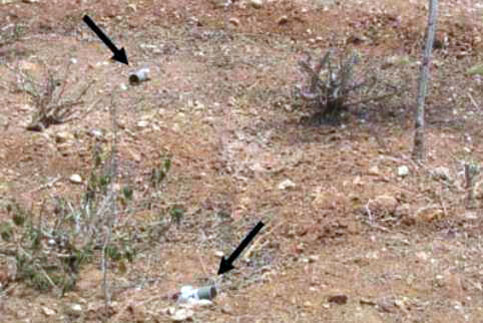Human Rights Watch 17 August 2006

Unexploded M42 cluster submunitions found outside the town of Kfar Roummane on August 15, 2006. These dud submunitions are extremely dangerous and may detonate if touched or moved. The presence or sighting of one is an absolute confirmation that there are many others in the immediate vicinity. (UNMAS)
NABATIYEH — United Nations deminers beginning emergency survey and clearance work in the south of Lebanon have identified 10 locations where Israel used artillery-delivered cluster munitions during the recent hostilities, Human Rights Watch reported today. Human Rights Watch researchers in Lebanon have inspected two of those sites in the village of Kfar Roummane.
Dangerous unexploded submunitions, duds that fail to detonate on impact but are still live and at risk of exploding, are present in areas of Nabatiyeh, Tabnine and Beit Yahoun, as well as areas adjacent to the 3km road connecting Tabnine and Beit Yahoun, U.N. demining officials said. They have been able to visit only a limited region so far, and fear that the 10 sites identified in the first two days could be the “tip of the iceberg.” U.N. teams have received reports of at least 16 casualties from cluster submunitions that exploded well after they had been fired, and they fear many more.
“Because of their wide dispersal pattern, cluster munitions should never be used in populated areas,” said Kenneth Roth, executive director of Human Rights Watch. “The laws of war don’t ban cluster munitions in all circumstances. But the use of cluster munitions in or near civilian areas violates the ban on indiscriminate attacks, because these weapons cannot be directed at only military targets.”
In addition, Human Rights Watch opposes all use of cluster munitions with high initial failure rates, including the weapons that Israel used in Lebanon, because of the prolonged danger they pose to civilians.
“Cluster submunitions with high initial dud rates effectively become antipersonnel landmines,” Roth said. “Even if civilians are not present at the time of attack, they risk stumbling onto the submunitions weeks, months or even years later, triggering fatal explosions.”
In Kfar Roumanne, Human Rights Watch researchers examined two areas that had been struck by Israeli cluster munitions. One site was among civilian homes on the edge of the village. Around two homes, Human Rights Watch researchers saw at least six impact marks from submunitions that had exploded, as well as four unexploded hazardous dud submunitions lying in the front yard of one house, and another on a tin roof nearby. Apparently no one was injured in that attack, since the residents had left the village by July 28. The Lebanese army has begun clearing the area.
The other site in Kfar Roumanne encompassed a field on the outskirts of the village and an adjacent olive grove. A farmer from the area said the attack took place on August 13 around midday, when the Israeli military fired four projectiles. He was unaware of any casualties and said that Hezbollah had been firing rockets from the grove. Human Rights Watch inspected the components of one projectile, which appeared to be a U.S.-manufactured M483 155mm artillery shell, which carries 64 M42 and 24 M46 submunitions. About two dozen hazardous submunition duds were visible in the area.
At both sites, the dud submunitions pose clear risks to civilians returning to the area. Israel clearly had a right to respond to Hezbollah rockets coming from the grove, but should have used weaponry that did not predictably pose a long-term risk to civilians.
A deminer working in southern Lebanon told Human Rights Watch that in 10 minutes he identified 100 hazardous submunition duds on the main street of Tabnine, before he stopped counting. He noted at least one case of “catastrophic failure,” where none of the submunitions in an artillery projectile exploded, leaving all of the submunitions scattered on the ground. This projectile landed just outside the main gate of the hospital in the center of Tabnine, he said.
The types of artillery-delivered submunitions used by Israel have an initial failure rate of at least 14 percent, according to U.S. military testing data. The failure rate may be higher in battlefield conditions.
Israel should immediately provide information to the U.N. Mine Action Coordination Center on the location of its cluster munition attacks and the specific weapons used, Human Rights Watch said. Israel should also provide technical, financial, material and other assistance to facilitate the marking and clearance of cluster duds and other explosive remnants of war.
“With refugees streaming home, we’re already seeing people falling victim to these dangerous duds,” said Roth. “A failure to act swiftly will lead to many more avoidable casualties.”
The U.N. Mine Action Coordination Center in southern Lebanon issued a warning about cluster submunitions on August 15. The duds “are extremely dangerous and may detonate if touched or moved,” the statement said. “They are small [about the size of a D-cell battery] and easily obscured by rubble and debris. The presence or sighting of one is an absolute confirmation that there are many others in the immediate vicinity.”
Israeli officials have given contradictory statements, with some denying any use of cluster munitions in the month-long fighting and others acknowledging use but claiming it was away from civilian areas. Human Rights Watch previously reported on Israel’s cluster munition attack on Blida on July 19 that killed one and wounded at least 12 civilians, including seven children.
An IDF spokesperson, asked about Israel’s use of cluster submunitions in Lebanon, told Human Rights Watch that, “We use all munitions within the confines of international humanitarian law and cannot give more details that would jeopardize our operations.”
U.N. deminers and the Lebanese army are already working to mark and exclude civilians from areas contaminated by unexploded cluster submunitions and other unexploded ordnance. Two explosive ordnance disposal teams from the British charity Mines Advisory Group began emergency clearance of dud submunitions in Tabnine yesterday.
Related Links